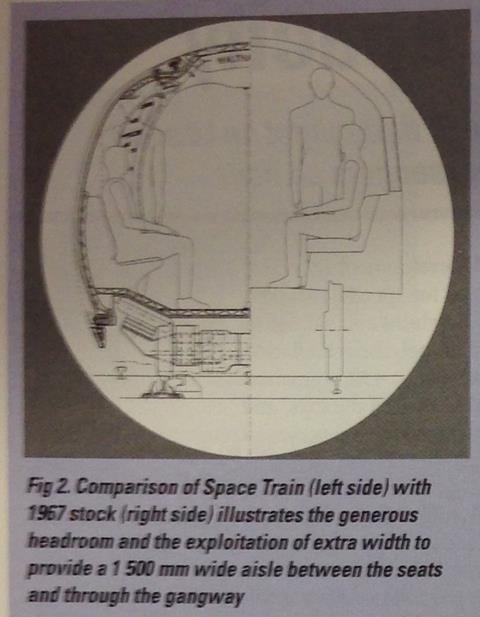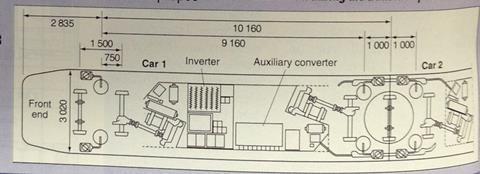Richard Hope examines a plan to lift peak throughput on London Underground’s Victoria line to 60 000 passengers an hour

IN THE YEAR to March 31 London Underground carried a record 832 million passengers. Projections show a further growth as LU prepares for the private sector to take responsibility for its asset base, including rolling stock, in 2000 (RG 5.98 p289).
Indeed, a substantial rise in patronage is vital if LU’s revenues are to fund all investment (apart from new lines) through annual ‘access’ charges in future years. It is also essential if the government’s strategy of reducing car dependence is to work in Greater London.
Yet several sections of the Underground are already overloaded. Moreover, some 60% of the 392route-km is operated by small-profile trains capable of using very restrictive 3·66m diameter Tube tunnels, many of which were bored over 90 years ago.
Since 1995, under the leadership of the then Rolling Stock Chief Engineer John Vint, LU engineers have been working up a concept design - currently known as ‘Space Train’ - that aims to carry 40% to 45% more passengers in a Tube train.
Combined with moving block signalling to reach 90sec headways (40 trains/h), the theoretical ability to double Tube capacity has been demonstrated - though much costly civil engineering would be needed at congested stations like Victoria to achieve this throughput in practice.
LU Rolling Stock Engineer Malcolm Dobell is currently in overall charge of the Space Train project. Development of the concept design is being led by Senior Design Engineer Chris Sharp. Dobell explains that the initial focus is on the Victoria line because the 1967 stock is coming up for renewal. Tunnels and stations were built in the 1960s to higher and more consistent standards, the whole route is in tunnel, and there is no interworking with other routes such as occurs on the Piccadilly, Bakerloo, and Jubilee lines to add complications.
At 3078mm, Space Train is 436mm wider at waist height than existing stock, which already overhangs the platform. The floor is 18 mm lower than the 1967 stock at the car centreline and 139 mm at the doorway sill plate in the tare condition, giving level access from LU’s 520mm high Tube platforms. Before it can operate, therefore, platform edges must be set back by about 170mm.
In addition, the intention is to abandon the third and fourth rails on the track in favour of a roof-mounted collector running on a positive rail, with negative return through the running rails in the conventional manner for metros. Installation of platform screens with doors matching those in the train may permit an increase in voltage, say to 1·5 kV. To put the rail beyond the reach of umbrellas poked into the gap above the vehicle doors, the conductor rail would be raised in the stations by 890 mm compared to the running tunnels.
Although the engineering aspects of transitional operation with a mixed fleet have been carefully weighed, the picture that emerges is of a quite fundamental line-by-line conversion programme extending over some 30 years.
A question currently being addressed by LU is how Space Train development fits into the private-public partnership framework announced by Deputy Prime Minister John Prescott on March 20. Dobell says LU’s immediate objective is to establish, through studies and contracts with suppliers, that the proposed capacity increase is technically and operationally feasible.
This would not necessarily require a prototype train. Instead, development contracts would be placed for specific components such as overhead current collection in a Tube tunnel, the articulation and bogie design with 430mm wheels, wide gangways between the cars, and the propulsion equipment.
At the same time, precise measurement of tunnels and structures would be carried out, and the aerodynamic effects of reducing the annular space around the train assessed.
This would pave the way for concession agreements with the proposed one, two or three asset management companies that included a requirement to increase capacity under defined circumstances. The intellectual property rights to LU’s concept design would then be made available to concessionaires and rolling stock suppliers, but it would be up to them to work out the details.
Clearly, there would have to be provisions in place to prevent mutually incompatible systems being developed, while still allowing the maximum freedom to innovate - a conflict which has yet to be resolved.
The Space Train concept

SPACE TRAIN, as currently conceived for the Victoria line, would probably consist of 12 articulated cars on 13 bogies totalling 137·6m in length, compared to 129·8m for a pair of four-car units of 1967 stock. With fully-automatic operation and platform screens, it is only necessary for the 24 double-doors, each opening to a clear width of 1664mm, to be inside the 132·6m distance between relay rooms at each end of the platforms.
Fig 1 shows the layout proposed for a 12-car train, although 10 to 13 cars are possible within the overall length fixed by platforms. A key parameter is the gap between platform and door sill; this must be limited to 100 mm for level access by wheelchairs and prams, whereas 250mm exists now at Bank station where LU’s most sharply curved platforms are to be found. Fortunately, Victoria line platforms are virtually straight. Even so, a hinged beam pivotted at each end onto adjacent cars at the articulation fills the small gap that exists at convex platforms. Gaps down to 40 mm are the aim.
Floor area is what counts when it comes to standing passengers. LU assumes 6/m2 at crush load in the aisles between longitudinal seats, and 8/m2 in vestibule areas around the doors. On this basis, there is a 53% increase from 178 to 274m2 per train compared with 1967 stock. The increase in standing passengers is even greater at 63% under crush load conditions because the effective vestibule area is so much larger. The wider aisle between longitudinal seats (1512 against 981mm) should make for more effective use of this standing area than on existing trainsets.
While much of the increase in floor area stems from the extra car width, with seated passengers set back to exploit the near-circular cross-section of Space Train, there are only 220 seats compared to the 304 in 1967 stock. Chris Sharp points out that if 90sec headways were introduced, the total number of seats per hour would actually rise by 8·5% from 8 106 at today’s 135 sec headways to 8 800.
Standing area includes the 1900mm diameter turntable at the articulation, which has to accommodate only a fraction of the rotational displacements common in light rail vehicles.
Nominal crush load is expected to rise from 1564 to 2273 passengers per train, a 45% increase. However, it is expected that the continuous 1·5m wide walkway throughout the train, compared with today’s narrow inter-car doors (which passengers are only supposed to use in emergency) will lead to better distribution of passengers along the train.
Sharp believes the extra height provided by a lower floor will allow tall people to stand closer to the sides and curved doors, and therefore boost loadings. As Fig 2 shows, the 95th percentile man who is 1876mm high could stand fully upright with his shoulders against a side wall or curved door in Space Train, whereas in 1967 stock he can only do so in the centre aisle.
That said, your reporter who is 1900mm high routinely stands jammed against the doors of 1967 stock, if not exactly in comfort.
The lower floor is central to the Space Train concept. The idea actually originated in 1995 with the roof-mounted conductor rail, which in turn stemmed from a desire to get rid of the present system which seriously inhibits good quality track maintenance. Since then, it has been driven forward by the need to achieve level access for mobility-impaired passengers on the Underground in years to come, and by the benefits of greater headroom.
Flattening the roof slightly means that Space Train is 35mm lower than 1967 stock at 2838mm. A design has been produced for LU by Brecknell Willis which mounts a shallow inverted light alloy rail with a stainless steel cap within the nominal 200mm available between train roof and tunnel segments.
Except for Northumberland Park depot, the Victoria line is all in bored tunnel. For the 42% of Tube lines which are in the open air, on tracks occasionally shared with full-sized trains, catenary and a pantograph with appropriate reach will be necessary.
Bogie debate

The three-axle bogies proposed by Sharp have already proved to be a controversial feature with manufacturers. Dobell comments that ‘we need to bottom-out that debate and are still open-minded; we have seen proposals for bogies with 1, 2, 3 and even 4 axles!’ In fact, Sharp’s ‘bogie’ (Fig 3) has two frames linked to the bodies on each side so that all three axles are steered through curves. The end bogies have two axles with only the outer wheelset steered. Clearly, two-axle bogies throughout would be preferable, but Sharp argues that they would be ‘right on the limit’ for wheel/rail contact stresses.
Diameter of the wheels when new is 430mm, compared to 360mm in four-axle bogies under rolling motorway wagons that carry complete lorries in central Europe. Sharp says he would welcome information or reports on the performance of small wheels (less than 650mm) from operators with experience extending over several years. Fax +44 171 308 3065 to contact him direct.
Dobell notes that ‘most of the debate with manufacturers that we have had so far has been generated by these bogies (above), the small wheels, and to a lesser extent the reduced underfloor space for equipment.’
AC motors slung under the car body would drive the outer axles of each articulation bogie; the centre axle is unpowered because of the tight space under the articulation. The motors and cardan drive shafts are slung off-centre at an angle to the driven axle because of the need to clear the negative conductor rail during the transition phase when old stock is still running.
Power requirement for each of the 24 traction motors would lie between 50 and 70 kW, depending on the performance requirement.
Space Train augmente la capacité du Tube
Space Train est le nom d’un programme destiné à accroître jusqu’à 60000 voyageurs à l’heure la capacité de la Victoria Line du métro de Londres, le London Underground. Circulant avec un espacement de 90 secondes grâce à un système de cantons glissants, les trains seraient à plancher bas avec caisses articulées et intercirculations de 1·5m de largeur. Ils seraient alimentés par caténaires au lieu du système actuel à deux rails conducteurs. Des études sont en cours afin de vérifier que le concept est viable aussi bien dans son aspect technique que pour l’exploitation, l’objectif étant de convertir les autres lignes à petit gabarit sur une période de trente ans. Avant de signer des contrats pour la réalisation, le London Underground pose la question de savoir comment le concept peut s’insérer dans le projet d’exploitation du métro faisant appel à des concessionnaires, dans le cadre d’un partenariat privé - public

















